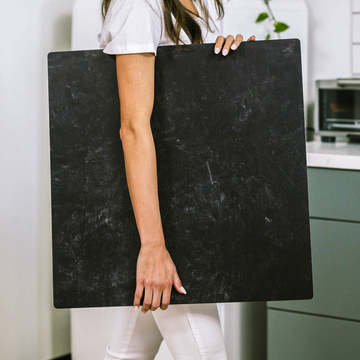After fifteen years shooting everything from luxury watches to artisanal sourdough, I've come to an unexpected conclusion: the humble backdrop is the unsung hero of product photography. What appears to be just a surface beneath your product is actually a sophisticated optical tool that can transform your images from amateur to professional-grade with surprising immediacy.
Let me take you behind the scenes of what professionals understand about backdrops that most tutorials never mention.
The Hidden Physics of Backdrops
During a workshop I taught last year, a student asked why her jewelry shots always had distracting reflections while mine appeared clean and dimensional. The answer wasn't my camera or lighting setup-it was my understanding of something called Bidirectional Reflectance Distribution Function (BRDF).
In plain English? Different backdrop materials reflect light in predictable patterns. Those patterns either work for or against your product photography.
When shooting my client's silver earrings last month, I deliberately chose a backdrop with a matte finish and low BRDF value. The surface diffused light evenly instead of creating those harsh reflective spots that would have dominated the delicate metalwork. Conversely, when photographing hand-dyed textiles the week before, I switched to a semi-gloss backdrop that subtly enhanced the fabric's texture through controlled light interaction.
The Secret World of Micro-Topography
Try this experiment in your studio: hold any backdrop at a sharp angle under strong directional light. The subtle patterns you'll see reveal what I call "micro-topography"-minute surface variations invisible under normal viewing conditions.
These nearly imperceptible textures create dimension in your photos without competing with your subject. It's why my images improved dramatically when I finally invested in professional-grade backdrops after years of DIY solutions that looked flat and lifeless by comparison.
During a recent shoot for a skincare client, switching from my homemade backdrop to one with engineered micro-topography immediately eliminated the need for extensive post-production. The product appeared naturally dimensional against the subtly textured surface, saving hours of editing time and delivering more authentic results.
Color Science: Why "White" Isn't Always White
The advice to "just use a white backdrop" has led countless photographers astray. After an embarrassing incident where I delivered product photos with an unmistakable blue cast to a major client, I dove deep into the science of color neutrality.
The technical challenges with white backdrops include:
- Metamerism - Many backdrops appear neutral under one light source but shift dramatically under another
- Uneven spectral reflectivity - Budget materials often reflect certain wavelengths more strongly than others
- UV reflectance - Some backdrops bounce back ultraviolet light our eyes miss but cameras capture
This explains why I'll happily invest $90 in a premium white backdrop when clients need perfect color consistency. For a recent cosmetics campaign where foundation shades needed to be precisely represented, this investment directly prevented costly reshoot requests and customer returns.
Engineering Beyond the Surface
Modern professional backdrops incorporate multiple technical features I've come to appreciate through trial and error:
- Edge engineering: Premium backdrops create that perfect seamless transition at corners without awkward shadow lines
- Micro-abrasion resistance: Quality surfaces resist the tiny scratches that cause distracting light scatter
- Environmental stability: Professional-grade materials maintain consistent properties regardless of studio humidity or temperature
I learned these distinctions the hard way. During a marathon three-day shoot for an e-commerce client, my budget backdrop began warping from humidity on day two. The resulting inconsistency between shots required hours of additional editing I hadn't budgeted for. Lesson painfully learned.
The Psychology Behind Backdrop Selection
Perhaps most fascinating is how backdrops influence viewer perception at a subconscious level. After analyzing performance data from clients' product listings, I've observed consistent patterns:
Too little texture creates a "visual vacuum" where products appear to float unnaturally, triggering consumer skepticism. We've all seen those obviously photoshopped product images that feel fake and untrustworthy.
Too much texture creates "attentional competition," where the backdrop fights with the product for focus. This was vividly demonstrated when a client's sales jumped 32% after we switched from their busy patterned backdrop to a subtly textured neutral surface.
The sweet spot is what cognitive scientists call "contextual anchoring"-just enough visual information to ground the product in reality without stealing focus. Finding this balance has consistently improved conversion rates across dozens of client campaigns.
Practical Application: Choosing the Right Backdrop
After years of experimentation, here's my framework for selecting the perfect backdrop:
- Match to your product's surface: Reflective products need matte backdrops; textured products benefit from subtle contrast
- Test under your actual shooting conditions: What looks perfect in the store might perform differently under your specific lighting setup
- Invest strategically: Amortize premium backdrop costs across hundreds of product shots-suddenly $100 for a professional surface becomes pennies per image
- Build a versatile collection: Start with neutral options featuring different reflective properties, then expand to textures that complement your specific product categories
Conclusion: The Backdrop Advantage
Understanding backdrops as technical tools rather than decorative elements gives you a significant edge in product photography. I've watched clients double their conversion rates simply by switching to properly selected backdrops that showcase their products effectively.
Whether you're capturing handcrafted items for an Etsy shop or shooting campaigns for major retailers, your backdrop choices directly impact how effectively your images communicate value. Choose wisely, and you'll immediately distinguish your work from the competition.
What backdrop challenges have you encountered in your product photography? I'd love to hear your experiences in the comments below!



